With the popularity of the Chinese film market, the growth rate of new projects in various theaters has also increased rapidly. Considering the economic benefits and audiovisual effects, cinema investors always want to get the best price/performance ratio. When making decisions about the design and procurement of the sound-reduction system, in the face of different product solutions and empirical theories, investors and even designers of theater audio systems sometimes cannot accurately determine whether their equipment configuration is the most reasonable. Power amplifier and speaker ratio From the figure we can see that 500W is 27dBw, 1500-2000W adds 500W power, but only 1.2dBW increase. That is to say, the higher the power, the higher the sound pressure level by increasing the power of the power amplifier is extremely low efficiency and extremely high cost. As can be seen from the above figure, in an indoor environment such as a cinema, after a distance of more than half of the room, the sound pressure level is not attenuated by 6 dB each time due to factors such as reflection of the room. In general, the room will provide an additional 3-4dB room gain, so in fact in many medium and large and immersive theater design, often in order to achieve the theoretical SPL requirements, the speaker will be too high. Due to the limitations of the speakers and amplifiers (to believe in theoretical indicators and calculations, but not superstitious on theoretical indicators and calculations) A speaker: imported famous brand P=1200W System A- High Power System B- Long Excursion It can be seen that the A speaker uses the “sensitivity +10log (rated power)†formula to calculate the result higher than the B speaker 1.7dB, and we see that the final decision of the actual unit stroke on the sound pressure level is considered, the B speaker is higher. Nearly 3dB of sound pressure level. From the comparison of the above two branded speakers, it can be seen that the DCA2422 has a consistent power output and low distortion under a 4Ω load (825W/4Ω), and the entire frequency band (different colors indicate different frequencies), and the international famous brand The power amplifier, although the parameter table has the same power output as the DCA2422, it can be clearly seen that only 1 kHz (green line) is consistent with the description, while other frequency bands cannot provide equivalent power output in the full frequency band, and the distortion is obvious. Higher than DCA2422. Final summary Fast Recovery Diode,Ultra Fast Recovery Diode,Fast Recovery Rectifier Diode,Fast Recovery Epitaxial Diode Shenzhen Kaixuanye Technology Co., Ltd. , https://www.icoilne.com
The following product department manager Liu Wei discussed and shared the reasonable matching of power amplifier and speaker power in the theater sound system configuration. Oriental Jialian hopes to give practitioners more awareness and thinking. 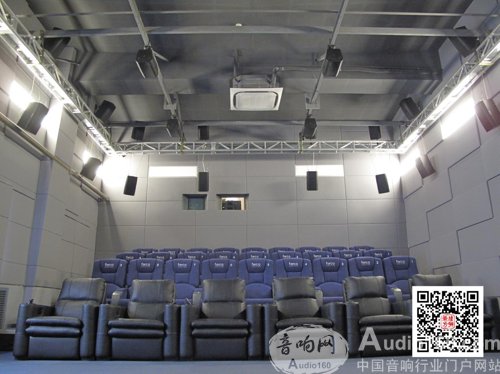
What often plagues us is the problem of matching the power of the amplifier to the speaker, which is also the highest proportion of investment in the theater restoration system. Is it better to use a power amplifier with a power amplifier? For a long time, the entire audio industry has always agreed that the rated power of the power amplifier is about 1.2-1.5 times the rated power of the speaker, and there are also two times the configuration in the sound reinforcement field. All in all, I would rather have a big horse-drawn car, nor a small horse-drawn cart. (In particular, there is a theory that a small horse-drawn carriage causes the power amplifier signal to be easily distorted, which causes the speaker to burn out. This is the so-called small power amplifier that is more likely to burn out the speaker. Reasons, this phenomenon has happened in reality, which is related to the quality of the selection of power amplifiers).
In order to achieve a 1.2-1.5 times power amplifier/speaker ratio, investors will invest extra cost to purchase a higher power amplifier. In fact, unlike sound reinforcement, in film applications, it is not the continuous sound pressure level, but more attention to the dynamics that can be achieved by the instantaneous system (short and shocking explosion sounds, gunshots). Moreover, compared to the continuous pink noise or sine wave used in the test, the content of the music or movie program is mostly at a power rating of 1/10, and 70% of the content of most movies is dialogue.
The rated power of a speaker and amplifier is the maximum average power that can be output without distortion. The power amplifier sine wave test signal itself has a 1.4-time undistorted margin from the rms voltage value to the peak signal voltage. A power amplifier rated at 500 Wrms is actually capable of outputting 1000 watts of signal without distortion.
We conclude that if the speaker selected by the cinema is a 1000Wrms rated power amplifier, then it is feasible to use the 500Wrms amplifier to drive. It is no problem when the instantaneous 1000W output is needed. In the case of pursuing the most cost-effective investment, it is a A good choice.
The question is back. Isn't it too afraid that the signal is too large, causing a square wave and burning the speaker? So why would someone use a 1.5-2 power amplifier to push the speakers? There are two factors that cause the speaker to be destroyed. One is thermal damage and the other is physical damage. Most of the burnt speakers are hot damaged. So simply speaking, the rated power of the speakers we say everyday is called thermal power rating in English, that is, the input of too much power to the voice coil of the speaker, resulting in sound. The circle is hot and the power is compressed until the voice coil is burned out. The meaning of English is a very intuitive explanation of the whole phenomenon. It is caused by overheating that causes the speaker to burn out. Distortion or not does not directly determine whether the speaker is burnt out. (We can consider these two extreme examples. One is whether a 20-watt amplifier can burn out a 200W unit after clipping distortion. Another example is the effect of pursuing distortion in modern music, deliberately producing a distorted waveform.) In short, if a 2000W amplifier continues to push a 1000W speaker and encounters a long-term big signal, the high-pitched sound of the speaker may burn out, even if there is no distortion, and even if it is not burned immediately, the 2000W amplifier produces The signal works on the edge of 1000W speaker distortion, and working long hours will reduce equipment life. In summary, if the content of the sound is not bursty, the content signal is stable, and the sound power level can be obtained by using the power amplifier higher than the speaker power. However, in most cases, it is unnecessary and the device life is degraded. . If the content of the sound is not certain, then using a 1:1 configuration is a safe and balanced solution. When it is known that the program signal has distortion content or a large dynamic change space (such as a movie), it is more suitable to use a power amplifier/speaker in a 1/2-1 power ratio.
How to improve sound pressure level
Close to the previous topic, if you need to increase the SPL (sound pressure level), many people like to use a larger power amplifier, 10log (power) calculation formula is deeply rooted in the hearts of the people. Let us see the chart below: 
Everyone often discusses the same sound level of two identical speakers after playing the same signal indoors. Is the sound pressure level increased by 3dB? The answer is 6 dB. Because not only is the power doubled, the doubling of the radiation area brings an additional 3dB of room gain. So if you need to get extra sound pressure level, especially for the LFE channel, a more effective way is to increase the number of subwoofers instead of replacing the higher power amplifier to push the subwoofer.
Misunderstanding of the formula for calculating sound pressure level
When we calculate the sound pressure level, we often use the square inverse proportional law formula -20log (away from the sound source distance), and calculate the distance attenuation in the last row of sound pressure level according to the distance of 6dB. What is easy to overlook is that the precondition of the formula is the attenuation in the free sound field environment. 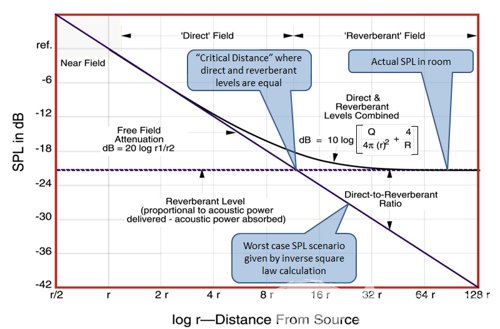
In addition to the above mentioned thermal power indicators, the sound pressure level that can be achieved especially in the low frequency part is limited by the paper tube stroke.
We are used to calculating the sound pressure level of a speaker using the sensitivity +10log (rated power). The negligible effect of the cone travel on the sound pressure level at the low frequency is ignored here (the thermal power parameter is no longer a determining factor).
Let's look at the following two AB speakers as an example.
Sensitivity=99.4dB
Xmax maximum stroke = 7.62mm
Volume Displacement Volume Movement = 689cc
B speaker: QSC 424C movie main expansion speaker (long stroke)
P=800W
Sensitivity=99.5dB
Xmax maximum stroke = 11mm
Volume Displacement Volume Movement = 940cc
The following figure shows the comparison test data of these two different stroke speakers: 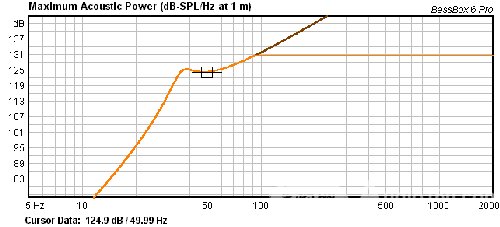
10Log(1200)+99.4 dB=130.2 dB
50 Hz Excursion Limit=124.9 dB 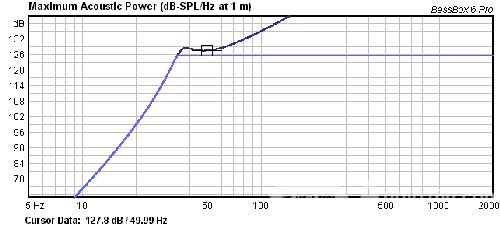
10Log(800)+99.5 dB=128.5 dB
50 Hz Excursion Limit=127.8 dB
In order to obtain higher sensitivity, it is often necessary to use a shorter voice coil, a stronger magnet and a shorter magnetic circuit, resulting in a corresponding shortening of the stroke, so the unilateral pursuit of high sensitivity is biased. In the case of the same sensitivity and power, the greater the distance the cone moves per unit time, the higher the sound pressure level. Here we see that the A speaker can't output the 130.2dB (a difference of 5.3dB) marked by the thermal power at 50Hz, but the B speaker can approach this value.
For power amplifiers, the parameters we see on weekdays are not necessarily true actual performance responses. Let us take the following picture as an example:
Comparison of QSC DCA 2422 with 4 ohms and the same power model of an international famous brand 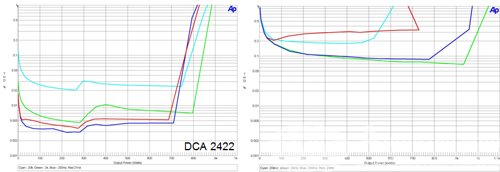
In summary, the largest proportion of the theater audio system is the speaker and amplifier. When selecting the speaker and amplifier, we must consider all the factors and investigate the actual use of the equipment. We have summarized the matching experience of the speaker and amplifier for many years. And the maintenance record in the process of use, wrote the above discussion article for the reference of practitioners, the simple formula calculation and theoretical derivation in the past will only make the film over-the-sound system costly, and its effect is lower than the expected imagination of the investment.
July 16, 2024